Miguel de Cervantes: Spain’s Greatest Writer
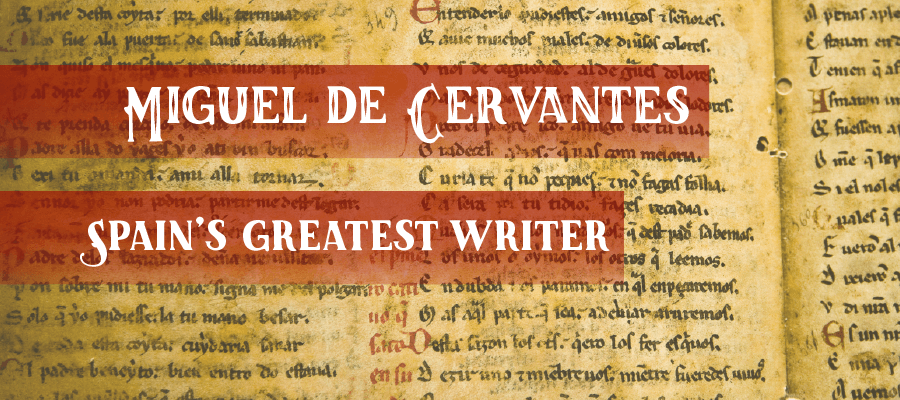
The great Modernist poet/literary critic T. S. Eliot once quipped, “Dante and Shakespeare divide the world between them. There is no third.” Although no literary critic would ever deny the importance of these two poets, there is an obvious “third” that Eliot failed to mention: 17th-century Spanish author Miguel de Cervantes.
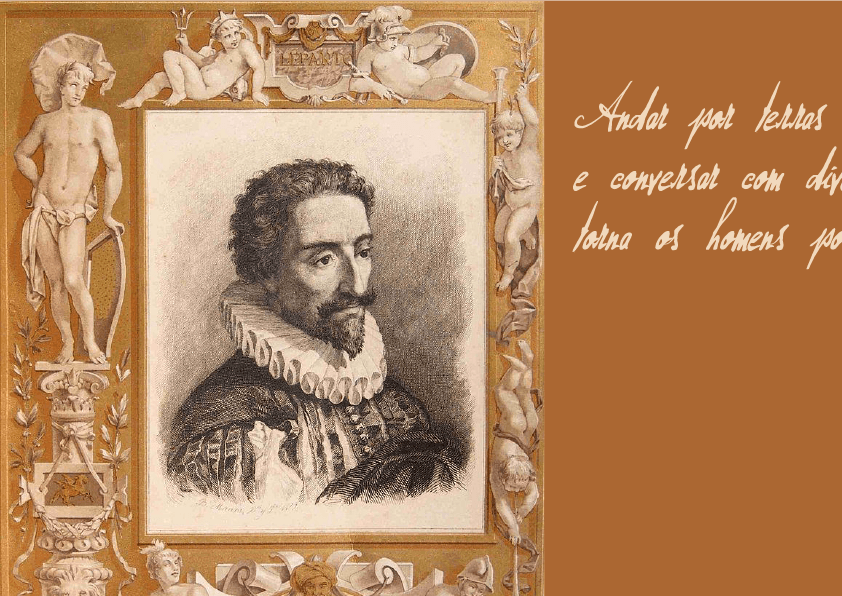
Miguel de Cervantes, 1547-1616, by Eugenio Hansen, OSF, via Wikimedia Commons
And Cervantes’s legacy rests on one legendary book: Don Quixote. This long novel is considered by many to be the first modern novel, and it serves as a major bridge between the Middle Ages and the Renaissance. Unfortunately, Don Quixote, like so many other great works of literature, fits Mark Twain’s humorous definition of a classic: “a book which people praise and don’t read.”
We hope that by the end of this short article on the life of Cervantes, you’ll feel the urge to check out a copy of his classic work. Although Don Quixote is long, it’s full of wit, pathos, and rich wisdom. There’s a reason why readers have passed down this work through the ages, and now it’s your turn to be inspired by the genius of Cervantes’s masterful tale.
Cervantes’s Childhood
Miguel de Cervantes was born in Madrid in 1547. He was the fourth of seven children. Miguel’s father, Rodrigo, worked as what was then called a “barber surgeon.” Believe it or not, physicians in medieval Europe weren’t allowed to perform surgery. All surgical tasks actually fell into the hands of barbers. Barbers in the past would be responsible for cutting hair, hacking off limbs, and even applying leeches to help cure certain ailments. Although this was an extremely demanding job, it paid very little. To make matters worse for the Cervantes family, Rodrigo suffered from deafness.
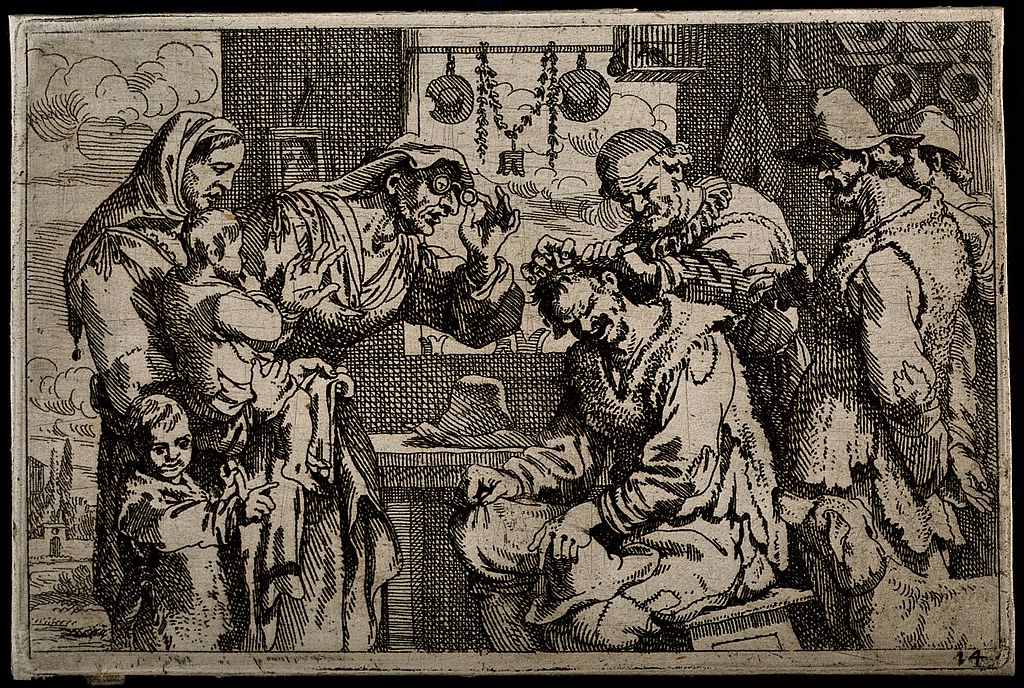
See page for author [CC BY 4.0 (http://creativecommons.org/licenses/by/4.0)], via Wikimedia Commons
Miguel’s mother, Leonor de Cortinas, was born into a noble family. Leonor’s father, however, squandered all the family’s wealth and had to sell Leonor off to regain some of his fortune. The Cervantes family moved often, going wherever Rodrigo could find a job.
Throughout this hectic childhood, young Miguel developed a passion for reading. Some biographers believe Cervantes was educated by the Jesuits, but there’s no concrete evidence for this. Others believe Cervantes must have studied for some time at the University of Salamanca in western Madrid. Again, there’s little evidence Cervantes ever attended university. Some scholars believe Cervantes must have learned how to read from a relative or a local teacher.
One juicy tidbit from Cervantes’s early life concerns his relationship with a barmaid named Josefina Catalina de Parez. Both Parez and Cervantes apparently fell in love and planned to ditch their parents to start a new life together. Parez’s father, however, caught wind of this scheme and barred his daughter from ever seeing Cervantes again. It’s quite possible that this lost love might have influenced Miguel’s later fiction.
Cervantes Enters Military Service
We do know that Cervantes composed poetry after the death of Elizabeth of Valois, the wife of Spain’s King Philip II. A few of these poems were published in 1569, but Cervantes never received any fame or money for them.
Just a few years later, Miguel de Cervantes took off for Italy as a member of the Spanish army. Scholars debate whether or not Miguel went off to Rome in order to read Italian literature, study Renaissance art, or to evade a suspicious warrant for his arrest after taking part in a duel. Whatever the case may be, Cervantes seems to have learned a great deal about the Italian language and culture from his stay here.
Cervantes’s first major engagement as a soldier was at the Battle of Lepanto in 1571. During this victorious fight against the Ottoman Empire, Cervantes’s left hand was completely maimed and he sustained two wounds to the chest. Cervantes continued serving in the Spanish army for a few years after this battle. It wasn’t until 1575 that Cervantes tried to return to Spain. Sadly, Cervantes was captured and enslaved by Barbary pirates in Algiers before he could reach his homeland. Cervantes wasn’t released until 1580 after his ransom was paid in full.
First Forays into Fiction
When Cervantes finally got back to Spain, he began his career as a writer in earnest.
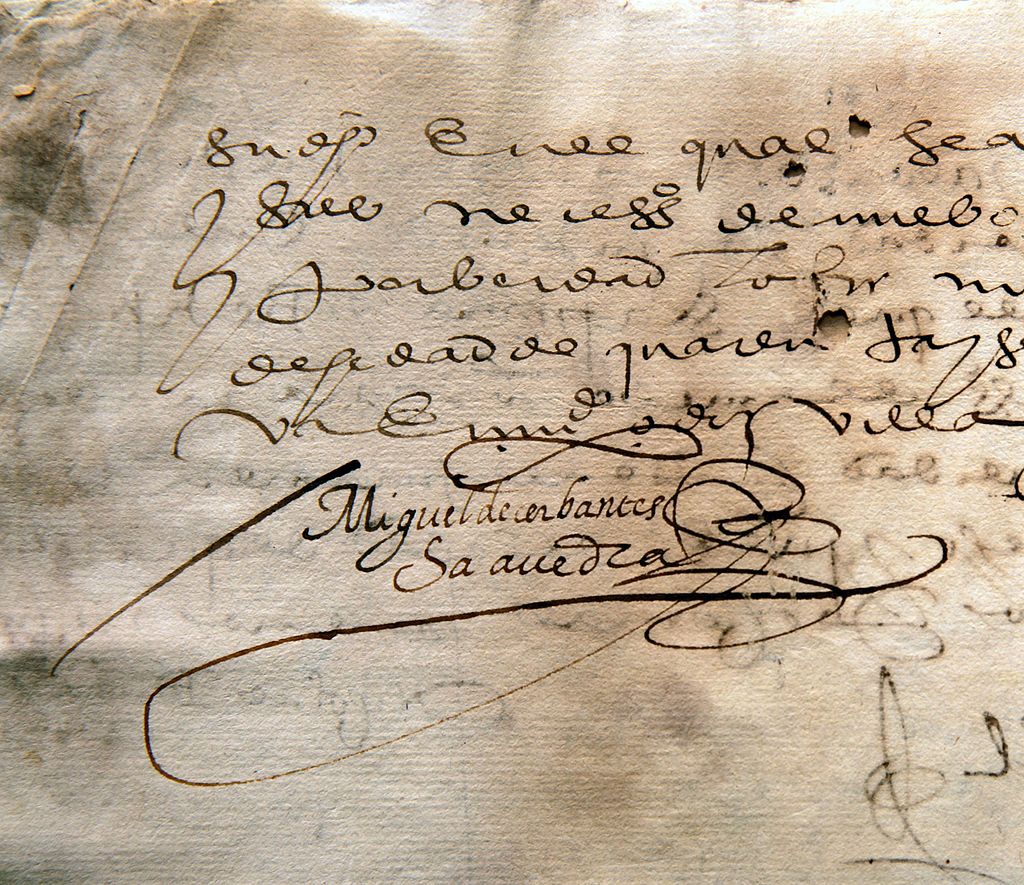
By Fondo Antiguo de la Biblioteca de la Universidad de Sevilla from Sevilla, España (Firma de Miguel de Cervantes (detalle) 2) [CC BY 2.0 (http://creativecommons.org/licenses/by/2.0)], via Wikimedia Commons
First, Cervantes wrote a romance novel called La Galatea. La Galatea, however, failed to appeal to the Spanish reading public. After the failure of his first novel, Cervantes turned all his energies towards the theater. At that time in Spain, the theater was by far the most lucrative place to be for any creative type. Cervantes wrote many plays for the Spanish stage, but all of them failed to bring him success. Only a few of Cervantes’s plays survive to this day.
In order to make ends meet, Cervantes was forced to work a menial job on the Spanish Armada collecting grain supplies. Cervantes was arrested once for “mismanagement” of these goods and thrown into a prison in Seville. He remained in prison between the years 1597-1602. Despite all these hardships, it was during this period in Cervantes’s life that he began work on his masterwork: Don Quixote.
Don Quixote
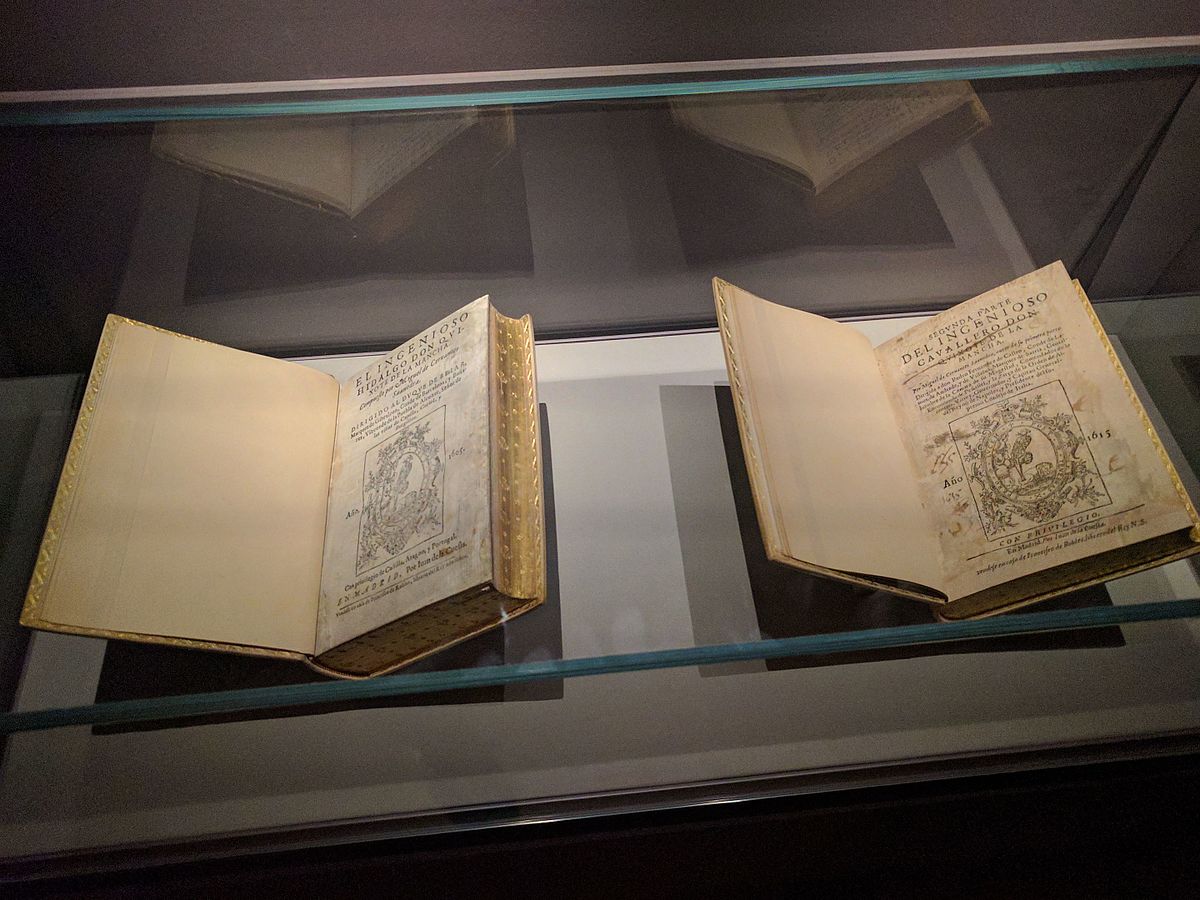
Second printing of the first edition of Don Quixote and first edition of the second part of El Quixote. Prado Museum, private collection. by Miguelazo84, via Wikimedia Commons
The first part of this epic novel was published in 1605, and it soon became a literary sensation; the second part was published in 1615. Readers all across Europe fell in love with the old man named Mr. Alonso Quixano, an obsessive reader of medieval romances with tales of chivalric love and knights in shining armor.
One day, Mr. Alonso calls himself Don Quixote de la Mancha and decides to bring both justice and chivalry back into the world. The novel follows Quixote’s quest to destroy giants (even when those “monsters” are in reality windmills), and engage in courtly love with an idealized beauty (even though Quixote’s beloved “Dulcinea del Tobasco” is actually a farm girl named Aldonza Lorenzo). The peasant Sancho Panza famously accompanies him through this trip. This novel has been read by many historians as a swan song to the high Middle Ages as the ideas of the Renaissance begin to spread across Europe.
Today, the novel has been translated into well over 50 languages, and many expressions from Don Quixote have entered into daily parlance. Of course, the word “quixotic,” which means “to be unrealistically idealistic,” comes straight from the Cervantes’s titular hero. Also, some scholars believe our English proverb “the proof is in the pudding” comes from an 18th century translation of Don Quixote. The original sentence, however, more accurately translates to “you will see when the eggs are fried” (Spanish: “al freír de los huevos lo verá”).
Cervantes’s Later Life and Death
Despite the success of Don Quixote, Cervantes never got the money or the attention he deserved in his waning years. He continued to write novels, such as The Labors of Persiles and Sigismunda, but nothing achieved the same level of acclaim as Don Quixote.
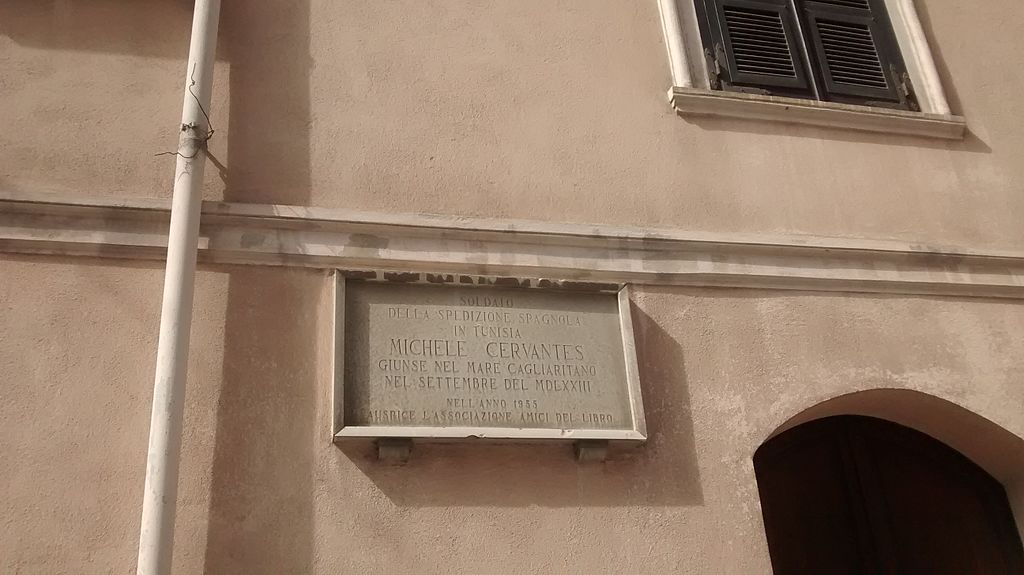
By Sabas88 (Own work) [CC BY 4.0 (http://creativecommons.org/licenses/by/4.0)], via Wikimedia Commons
Cervantes died on April 23, 1616 in Madrid. He was 68 years old. Most believe the cause of his death was due to cirrhosis of the liver. The date of Cervantes’s death is quite significant for literary historians, because the officially recorded death date for William Shakespeare was also April 23, 1616.
As Harold Bloom, an award-winning American literary critic, once wrote:
“Cervantes and Shakespeare…are the central Western authors, at least since Dante, and no writer since has matched them.”
Although both of these men were literary geniuses, there’s very little evidence either one knew of the other’s works. Cervantes was buried in an unmarked grave, but his remains were identified by a team of scientists in 2015.
Cervantes’ Meaning for Literature
Cervantes’s influence on future novelists has been immense. All of these authors have cited Don Quixote as a major influence on their work:
- Gustave Flaubert
- Franz Kafka
- Fyodor Dostoyevsky
- Johann Wolfgang von Goethe
Spanish scholar Miguel de Unamuno went so far as to call Don Quixote “the Spanish Bible.” Everyone who has read Don Quixote has been dazzled by the work’s wit, wisdom, and grace.
So, what are you waiting for? Now it’s your turn to experience the greatness of Cervantes firsthand!
Don Quixote Book Poster
Love this Don Quixote by Miguel de Cervantes? Read it right off the wall with our Don Quijote book poster! This 24″x18″ text poster contains up to Chapter 25 of Cervantes’s epic novel (in the Spanish language).






Leave a Reply
Be the First to Comment!